Violin vs Viola: 7 Differences, Pros and Cons
The violin and the viola are two of the most prominent orchestral string instruments in the world of classical music and beyond. They share similarities in their appearance, technique, and repertoire, yet each has unique qualities that distinguish it from the other. Lots of musicians play both violin and the viola.
In this article I explore the seven differences between the violin and the viola, discuss the pros and cons of each instrument, and examine which might be harder to learn.
7 Differences between the violin and the viola
- Size and shape
- Weight
- Tuning
- Clef
- Bow
- Role in the orchestra or ensemble
- Playing technique
Watch the quick video on the right to see and hear. Below I will go into depth into each of the seven differences between the violin and the viola. After that we’ll discuss the pros and cons, which one is harder to learn and how difficult it is to switch.
#1 Size and shape
Violin vs viola size
The first difference you’ll notice between the violin and the viola is the size: the viola is bigger. Both violins and violas come in different sizes. The violin is generally smaller, with an average body length of about 14 inches (35.5 cm), while the viola is larger, typically ranging from 15 to 18 inches (38 to 45 cm). This size difference affects not only the instrument’s weight but also the spacing of the strings and the overall feel when played.
Interesting detail is that compared to the body of the violin and the cello, the viola ‘should have been’ bigger for the range. However, it wouldn’t be able to play it in the same position. The fact that the viola’s body is relatively small for it’s pitch, gives the viola it’s typical timbre. I’ll explain all about violin vs viola tuning below.
Click here for a violin size chart and click here for a viola size chart.
Violin vs viola shape
The proportions and shape of the violin and the viola are generally the same. However, sometimes for example the body of the viola is relatively bigger (to get a good sound) and the neck is relatively shorter (to still be comfortable to play).
In the image below you’ll see a 4/4 violin and 16 inch viola side by side.
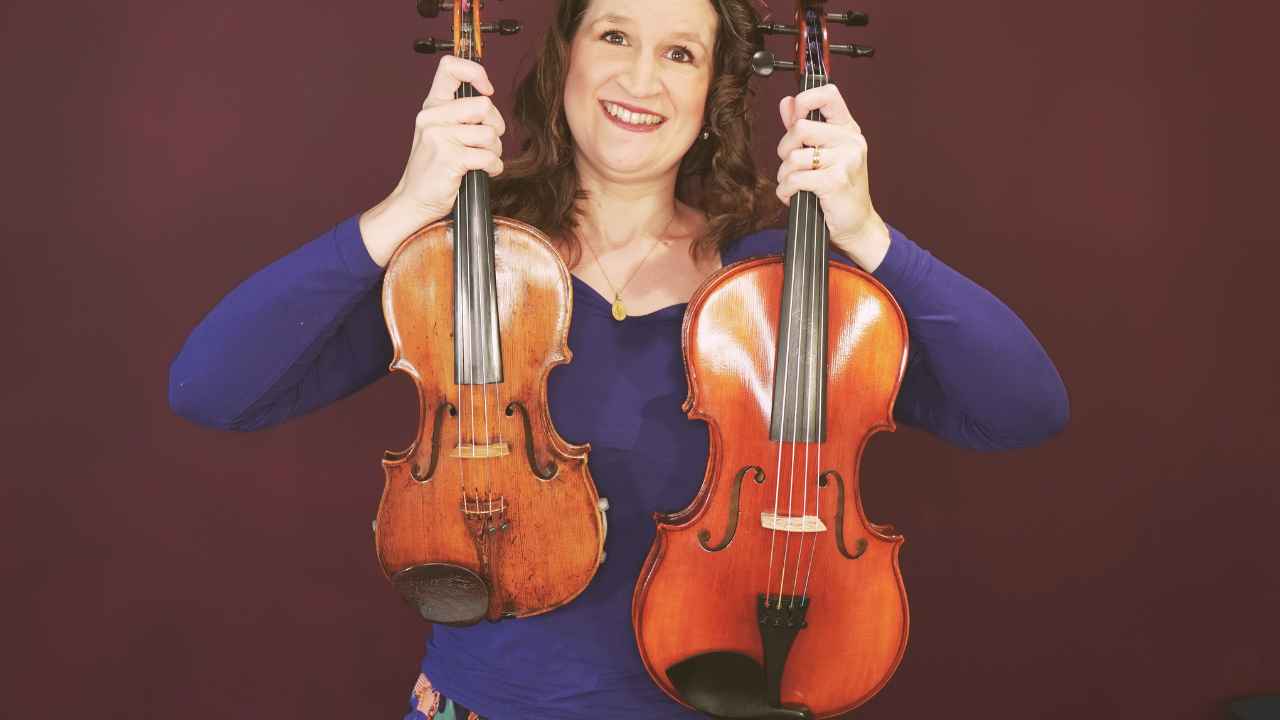
#2 Weight
Violin vs viola weight
As the viola is bigger than the violin, it’s also heavier. The violin’s weight is approximately 400 to 500 grams (0.88 to 1.1 pounds). The viola’s weight is approximately 575 to 700 grams (1.27 to 1.54 pounds). You can imagine that for those with a smaller builds, it’s easier to play the violin for extended periods of time. The added weight of the viola can cause more strain on the shoulders, neck, and arms, especially during long practice sessions or performances. This requires violists to develop greater physical endurance and may necessitate more careful attention to posture and playing technique to avoid injury.
Despite these differences, both instruments are designed to be manageable for most players with proper training and practice. Adjustments in playing technique and support accessories (chinrest and shoulder rest) can help mitigate the physical demands of each instrument. Picking the right size is also crucial.
#3 Tuning, sound and playing range
The viola sounds lower than the violin. Both instruments have four strings. The violin is tuned in perfect fifths: G3, D4, A4, and E5. The viola, on the other hand, is tuned a fifth lower: C3, G3, D4, and A4. This difference in tuning contributes to the viola’s deeper tone and impacts the fingering and playing techniques for musicians. To tune your violin or viola, check out my free online tuner right here.
Differences and similarities of violin vs viola tuning
The G, D and A strings of the violin and the viola are tuned in the same pitch. However, the open strings when played sound a bit different as the violin and the viola have different timbres. The viola has a lower C string that the violin doesn’t have and the violin has a higher E string that the viola doesn’t have.
Playing range of the violin vs the viola
The difference in tuning of the strings causes the playing range of the violin and viola to be different. The violin’s range extends from the G3 note below middle C to the A7 note, whereas the viola’s range starts at C3 and goes up to about A6. See the image below for the range of the violin vs the viola. Please note that the true playing range is usually bigger, certainly if one also counts the harmonics.
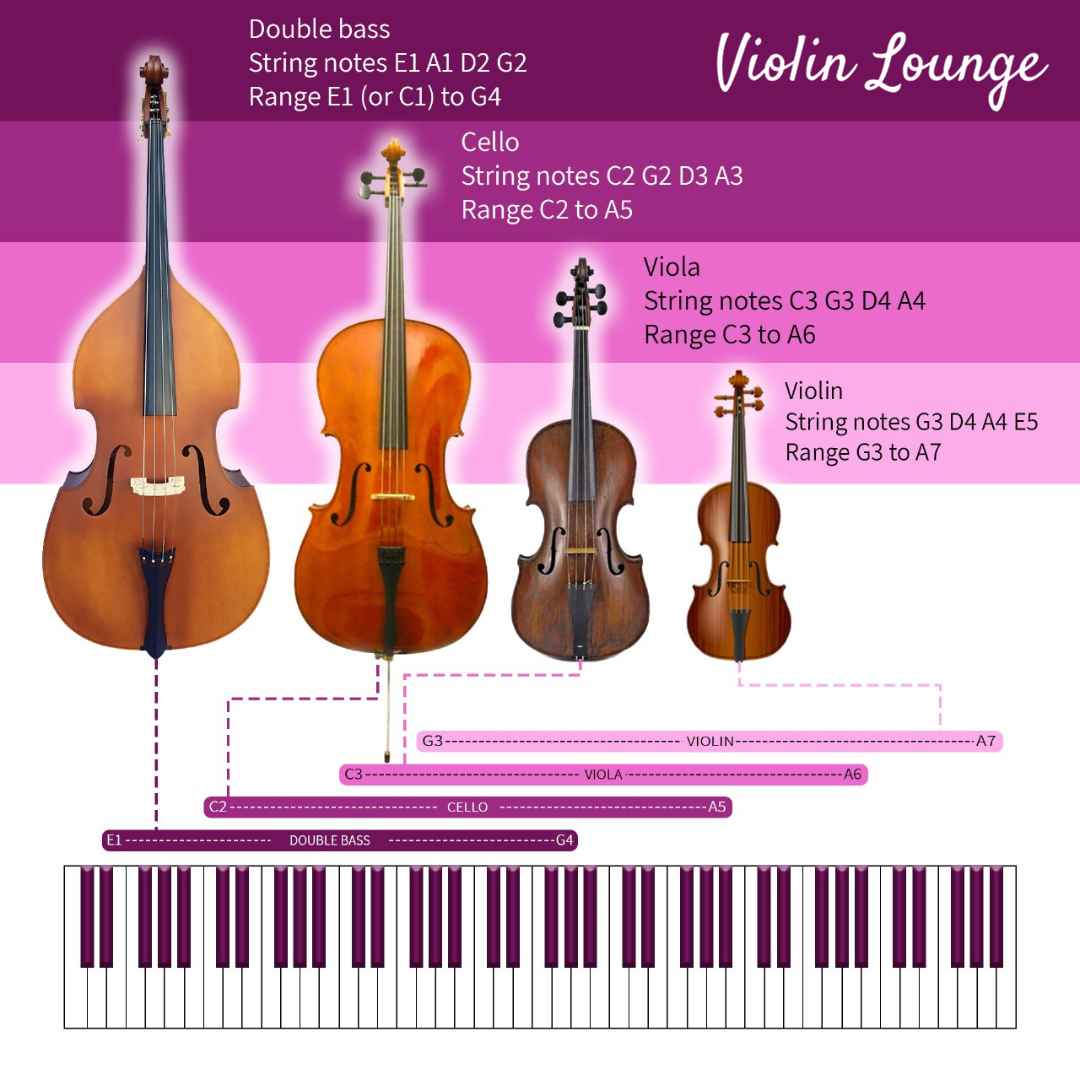
#4 Violin vs Viola clef
Violinists and violists read in a different clef. The viola clef reads seven notes lower than the violin clef.
Violin clef
-
Clef: The violin primarily uses the treble clef. This is the same as the right hand of the piano.
- Range: The treble clef suits the violin’s higher pitch range.
- Notation: In the treble clef, the notes are notated on a five-line staff with the second line from the bottom representing the G note above middle C.
Viola clef
-
Clef: The viola primarily uses the alto clef, also known as the C clef, where the middle line of the staff represents the note C4 (middle C).
-
Range: The alto clef fits well with the viola’s mid-to-low pitch range.
- Transition to Treble Clef: For higher passages, the viola music sometimes switches to the treble clef to accommodate notes that extend beyond the range of the alto clef. This transition helps avoid excessive ledger lines above the staff in the alto clef.
- Notation: In the alto clef, the notes are notated on a five-line staff with the center line representing middle C. This clef is unique to the viola and a few other instruments, making it somewhat specialized.
Summary of Clef Differences
-
Violin: Treble clef is the standard, facilitating the notation of higher pitches comfortably.
- Viola: Primarily uses the alto clef, with occasional switches to the treble clef for higher passages, accommodating its broader and lower range compared to the violin.
Understanding these differences in clef usage is crucial for musicians who play both instruments, as it affects how the music is read and interpreted.
To illustrate the violin vs viola clef, see the image below where the open strings of the violin and the viola are notated in their own clefs. Please remember that the G, D and A string of the violin and viola have the same pitch.
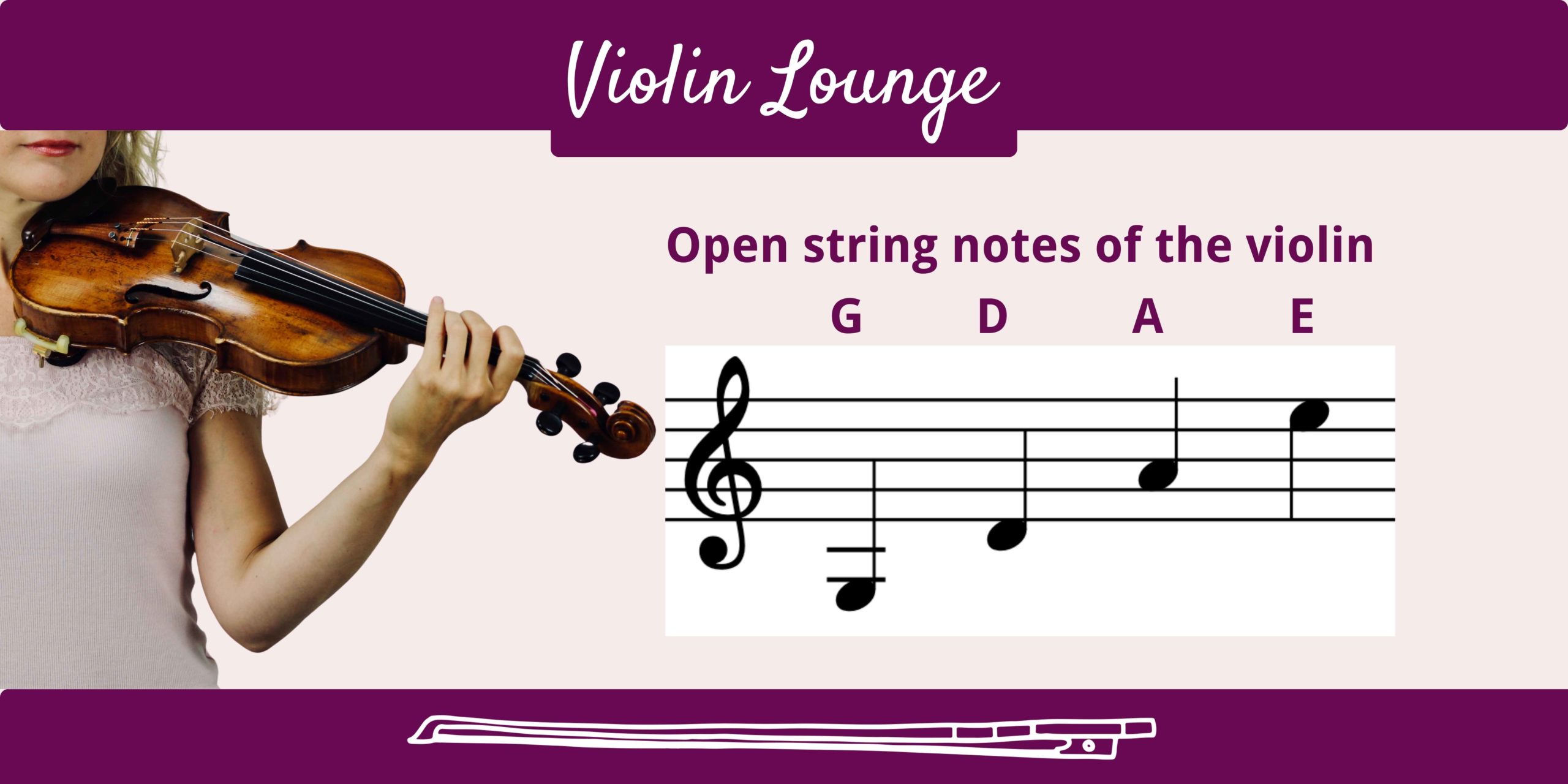
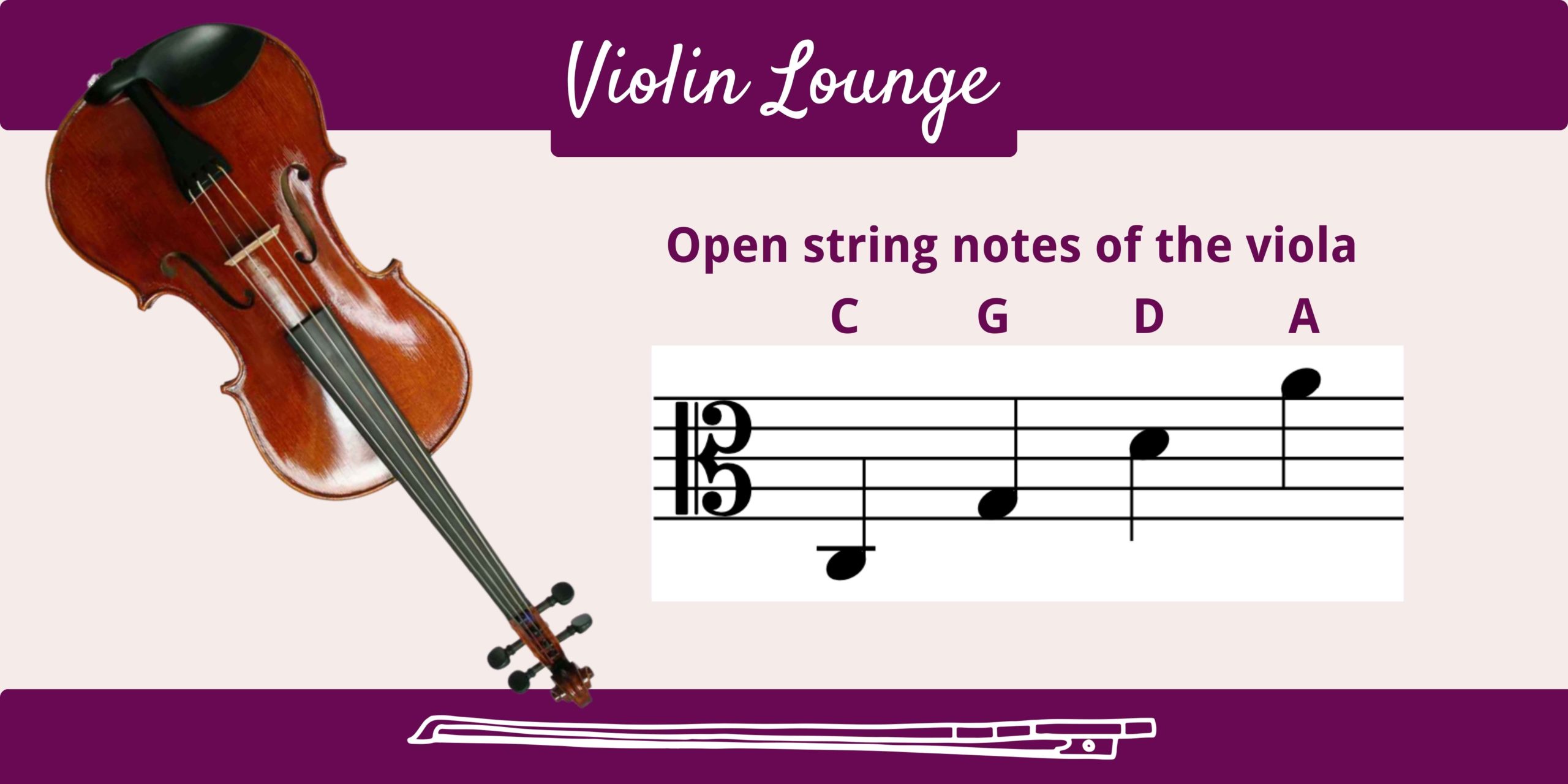
#5 Violin vs Viola Bow
Violinists and violists use different type of bows.
4 Differences Between the Violin Bow and the Viola Bow
#1 Frog shape
If you have a bow in your hands and you’re wondering if it’s a violin or viola bow, the easiest way to determine this is to look at the frog. Take a look at the corner of the violin vs viola bow in the image below. The corner of the violin bow has a sharp edge, while the corner of the viola bow has a round edge. Also the viola frog is larger.
There are exceptions (as always in music, haha) as Arcus makes violin bows with a round corner at the frog. However, these frogs are much smaller than a viola frog, even as a violin frog. It’s made to accommodate the lighter weight of these bows. Also in historical bows there are different designs of frogs.
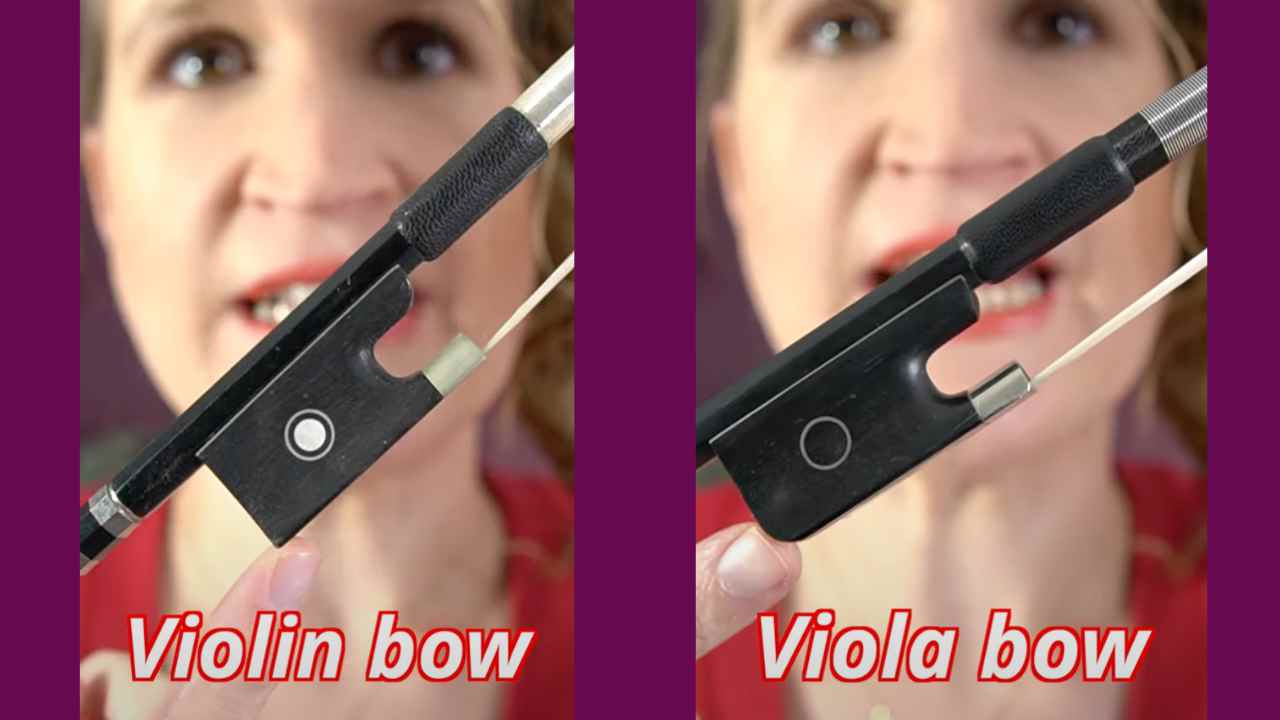
#2 Size
- Violin Bow: The typical length of a violin bow is about 74.5 centimeters (29.3 inches).
- Viola Bow: The typical length of a viola bow is slightly longer, around 75 centimeters (29.5 inches), though this can vary slightly by manufacturer and player preference.
Lots of makers make their violin and viola bows the same length as this depends more on the arm length of the player than the instrument.
#3 Stick Shape
- Violin Bow: The stick of the violin bow is generally round or octagonal in cross-section, tapering smoothly from the frog (the part of the bow held by the player) to the tip.
- Viola Bow: The stick of the viola bow is also round or octagonal, but it is designed to be slightly thicker and stronger to accommodate the heavier strings and greater tension of the viola.
#4 Weight
- Violin Bow: A standard violin bow weighs between 58 to 62 grams.
- Viola Bow: A standard viola bow is heavier, typically weighing between 70 to 74 grams. The added weight helps produce a deeper, richer sound suitable for the viola’s lower range.
Other Considerations
- Balance: The balance point of the viola bow is often positioned slightly differently to accommodate the heavier weight and provide better control over the larger strings.
- Hair Tension: The hair tension in a viola bow is typically adjusted to be slightly higher than in a violin bow, again to manage the thicker strings and greater resistance.
- Frog: The frog on the viola bow is usually larger and more robust than that on the violin bow to help manage the additional weight and tension.
- Materials: Both bows can be made from similar materials, such as pernambuco wood for high-end bows or carbon fiber for more durable options. However, the viola bow might have a slightly different construction to accommodate its larger size and heavier weight.
Impact on Playing
- Violin Bow: The lighter weight and size make it easier to perform fast, agile bowing techniques, making it suitable for the violin’s bright, high-pitched sound.
- Viola Bow: The additional weight and strength required for the viola bow make it more suited to producing the deep, rich tones of the viola. Players often need to use slightly different techniques to manage the greater resistance of the thicker strings.
Understanding these differences is crucial for players who switch between the violin and the viola, as it influences their technique, control, and the sound they produce. Below I will explain some more about switching between violin and viola.
# 6 Role in an ensemble or orchestra
The roles of the violin and viola in an ensemble or orchestra are distinct yet complementary, contributing to the overall texture and harmony of the music. Here’s a detailed look at how each instrument typically functions within these settings:
Violin in an Ensemble or Orchestra
1. Melody and Lead Parts
- Primary Role: In orchestral settings, the violin often carries the melody or the principal theme. This is due to its bright, penetrating sound and wide range, which make it well-suited for leading and delivering prominent musical lines.
- Solo Performances: The violin frequently takes on solo parts in concertos, showcasing virtuosic passages and intricate melodies that highlight the player’s skill.
2. Upper Harmony and Texture
- Harmonic Contributions: Violins also play important harmonic roles, particularly in higher registers. They often perform the upper harmonies and provide textural depth in both orchestral and chamber settings.
- Division: In orchestras, the violin section is usually divided into first and second violins, with the first violins typically handling the principal melodic lines and the second violins often providing inner harmonies and counter-melodies.
3. Orchestral Tuning
- Role in the String Section: The violin section is central to the string section of an orchestra, often driving the overall sound and providing the leading voices in many orchestral works. The large number of violinists (usually 8-16) ensures that their sound is prominent and can be tailored to the demands of the music.
Viola in an Ensemble or Orchestra
1. Inner Voices and Harmony
- Primary Role: The viola plays a crucial role in filling out the inner voices and harmonic structure of the music. Its rich, warm tone is ideal for blending with other instruments and creating a fuller, more complex sound.
- Supportive Function: Rather than leading with prominent melodies, the viola typically supports the harmonic framework of a piece, often playing counter-melodies or harmonic underpinnings.
2. Complementing and Balancing
- Blend with Other Instruments: The viola’s timbre helps to balance the sound of the string section and blend with both the higher-pitched violins and the lower-pitched cellos and basses. Its role is to bridge the tonal gap between the violin and the cello.
- Ensemble Dynamics: In chamber music settings, the viola often takes on a role similar to that in an orchestra but with more frequent opportunities to play prominent, characterful lines, depending on the piece.
3. Orchestral Tuning
- Role in the String Section: Although fewer violas are typically used in orchestras (usually 6-12), their role is no less important. They provide essential harmonic support and add depth to the string section’s overall sound. The viola’s position in the string section is crucial for achieving a balanced and harmonious orchestral texture.
Summary of Roles
Violin:
- Melodic Lead: Carries the main melody or theme in many pieces.
- Upper Harmony: Contributes to the high-range harmonics and textures.
- Soloistic: Frequently features in solo roles and virtuosic passages.
- Section Division: Includes first and second violins, with distinct roles in melody and harmony.
Viola:
- Inner Voices: Provides harmonic depth and counter-melodies.
- Harmonic Support: Bridges the tonal range between violins and cellos/basses.
- Complementary Role: Enhances the overall blend and balance of the string section.
- Chamber Music: Plays a more versatile role with opportunities for prominent lines.
Both instruments play integral roles in an ensemble or orchestra, with the violin often leading with melodies and the viola enriching the harmonic texture. The interplay between the two adds depth and complexity to the music, contributing to a rich and balanced orchestral sound.
#7 Playing technique
There are many similarities of playing technique between the violin and viola, which is why it’s lots of fun to switch between both. To the untrained eye the technique might seem similar. However, each instrument has their own nuances. Let’s discuss them:
1. Instrument Size and Position
- Violin: The violin is smaller and lighter, which generally makes it easier to handle and maneuver. It is typically held slightly higher on the shoulder and closer to the neck.
- Viola: The viola is larger and heavier, requiring adjustments in posture and grip. Players often have to hold the instrument lower on the shoulder and slightly away from the neck to accommodate its size.
2. Finger Spacing and Stretch
- Violin: Due to the smaller size and higher pitch range, finger spacing on the fingerboard is closer together. This allows for faster, more agile finger movements.
- Viola: The larger size means wider finger spacing, necessitating greater finger stretch and strength. This can be more challenging, especially for players with smaller hands.
3. Bow Technique
- Bow Weight and Pressure: Viola bows are heavier than violin bows, requiring more arm weight and pressure to produce a rich sound.
- Violin: Lighter bow, typically requires lighter, faster bow strokes and a focus on agility and precision.
- Viola: Heavier bow, necessitating deeper, slower bow strokes to fully resonate the thicker strings.
- Bow Hold: Both instruments use the same basic bow hold, but the angle and weight distribution differ due to the instrument size and string resistance.
- Violin: Often allows for quicker, more delicate bowing techniques like spiccato and sautillé.
- Viola: Requires more arm weight and a firmer grip to sustain sound, often resulting in a slightly different bowing style.
4. Left-Hand Technique
- Shift and Positioning:
- Violin: Higher positions are more frequently used, demanding quick and precise shifts.
- Viola: Shifting to higher positions requires more effort due to the larger size and wider fingerboard.
- Vibrato:
- Violin: Typically lighter and faster to match the instrument’s brighter tone.
- Viola: Often slower and wider to enhance the instrument’s warm, rich sound.
5. Tuning and Intonation
- Violin: Tuned in perfect fifths (G-D-A-E), the violin’s higher pitch makes intonation very sensitive. Small finger adjustments can have a noticeable impact on pitch accuracy.
- Viola: Tuned a fifth lower (C-G-D-A), the viola’s tuning contributes to its deeper sound. The wider finger spacing and larger size can make precise intonation more challenging.
6. Repertoire and Technique Requirements
- Violin:
- Repertoire often includes virtuosic passages requiring high agility, fast scales, and arpeggios.
- Emphasis on clarity, brilliance, and projection, which influences technical focus.
- Viola:
- Repertoire includes rich, harmonic inner lines and counter-melodies, often demanding sustained, expressive playing.
- Techniques focus on producing a full, warm tone and managing the physical demands of the larger instrument.
7. Physical Demands and Ergonomics
- Violin:
- Generally less physically demanding due to its smaller size and lighter weight.
- Ergonomics are more suited to a wide range of players, including young beginners.
- Viola:
- More physically demanding, requiring greater endurance and strength.
- Ergonomics can be challenging, particularly for smaller players, often necessitating adaptations in playing posture and technique.
Summary
Violin:
- Size: Smaller and lighter, easier to handle.
- Finger Spacing: Closer together, allowing for agility.
- Bow Technique: Lighter bow, quicker strokes.
- Left-Hand Technique: Higher positions frequently used, faster vibrato.
- Intonation: Highly sensitive due to higher pitch.
- Repertoire: Focus on virtuosity, agility, and projection.
Viola:
- Size: Larger and heavier, requiring different posture.
- Finger Spacing: Wider, necessitating greater stretch and strength.
- Bow Technique: Heavier bow, requiring more pressure.
- Left-Hand Technique: Slower shifts, wider vibrato for a richer sound.
- Intonation: More challenging due to size and wider spacing.
- Repertoire: Focus on harmonic support, expressive, sustained playing.
Pros and cons of the violin vs the viola
Now you’ve learned all about the differences between the violin and viola, we can name some pros and cons of each instruments.
Pros and Cons of the Violin
Pros
- Versatility and Repertoire: The violin has a vast and varied repertoire, spanning multiple genres from classical and jazz to folk and contemporary music. Its versatility makes it a popular choice for solo performances, orchestral roles, and chamber music.
- Brighter Sound: The violin’s bright, clear sound can carry over an orchestra, making it ideal for melodic lines and solos. Its ability to project makes it a favorite for concertos and symphonies.
- Size and Portability: Being smaller and lighter, the violin is easier to handle, especially for younger players or those with smaller hands. Its portability is a practical advantage for musicians who travel frequently.
Cons
- Competition and Saturation: The popularity of the violin means there is significant competition among violinists. Achieving distinction in the field can be challenging due to the high number of proficient players.
- Physical Strain: The violin requires precise finger placement and bowing technique, which can lead to physical strain or injury if not executed properly. Violinists often face issues like tendonitis or repetitive strain injuries.
- Intonation Sensitivity: The smaller size and higher pitch of the violin make intonation (playing in tune) a critical and often challenging aspect of performance. Minor deviations can be more noticeable, demanding high precision from the player.
Pros and Cons of the Viola
Pros
- Unique Sound: The viola’s rich, mellow tone provides a unique voice within ensembles. Its warm sound is highly valued in orchestral and chamber music, offering a distinct timbre that complements other instruments.
- Demand for Violists: There is generally less competition among violists compared to violinists. Orchestras and chamber groups often need more violists, increasing opportunities for skilled players.
- Role in Ensembles: The viola frequently plays inner harmonies and counter-melodies, contributing to the texture and depth of the music. This role can be intellectually stimulating and musically rewarding.
Cons
- Limited Solo Repertoire: The viola has a more limited solo repertoire compared to the violin. Although there are notable concertos and sonatas, the breadth of available music is narrower.
- Physical Demands: The larger size and heavier weight of the viola can pose physical challenges, particularly for players with smaller frames. Extended playing periods can lead to strain on the shoulders, neck, and arms.
- Projection Issues: The viola’s deeper tone does not project as easily as the violin’s. In orchestral settings, violists must work harder to ensure their sound is heard, which can require additional technique and effort.
Is it harder to play violin vs viola?
You’ve learned all differences and pros and cons between the violin and the viola. Now we’re ready to answer the burning question you might have had when you started reading: is it harder to play the violin than the viola?
Both instruments know the challenges that all bowed instruments have: playing in tune on a fingerboard without frets and learning very subtle bowing technique to make a good sound.
In the pros and cons we’ve discovered that the violin is smaller and lighter, which makes playing it easier in a way. On the other hand there’s more virtuoso repertoire expected from you, the notes are closer together on the fingerboard and the competition is killing. The viola is heavier and larger, the finger spacing requires more stretch and it requires a lot of control to make a good sound.
Both the violin and viola have their unique challenges, and determining which is harder to play ultimately depends on individual circumstances:
- For Beginners and Young Players: The violin may be easier to start with due to its smaller size and lighter weight.
- For Players Seeking Unique Opportunities: The viola might offer more opportunities in ensembles and orchestras due to less competition and high demand for violists.
- For Those Who Enjoy Technical Challenges: The violin’s demanding repertoire and sensitivity to intonation might provide a more rigorous technical challenge.
- For Those Who Prefer Harmonic and Textural Roles: The viola’s role in providing inner voices and harmonic depth can be musically rewarding.
Ultimately, the “harder” instrument is subjective and varies based on personal physical attributes, musical goals, and preferences. Mastery of either instrument requires dedication, practice, and an understanding of its unique characteristics.
My personal answer: choose which one you find sounds most beautiful. Mastering any instrument requires a lot of practice and just LOVING your instrument will make that road so much more pleasant.

Hi! I'm Zlata
Classical violinist helping you overcome technical struggles and play with feeling by improving your bow technique.
How hard is it to learn the viola as a violinist?
In this funny video you can see me pick up the viola from scratch as a violinist and see my 1 minute, 10 minute and 1 hour progress. This gives you a rough idea what it’s like to switch from violin to viola.
Is a violin more expensive than a viola?
The violin is known to be a very expensive instrument. Stradivari violins and are sold for up to 20 million dollars. However, Stradivari also made violas and the first place on the list of the most expensive instruments in the world is occupied by the “MacDonald” Stradivarius viola, which is valued at over 45 million dollars.
However that might not be the price range you’re looking in ;). In general if we’d buy a violin or viola from the same maker, the viola is more expensive. The simple reasons are that a viola requires more precious wood and there’s more surface to work on.
For example, an excellent student viola that’s great to start out on, is the Fiddlerman Artist viola. It costs a little over $ 800 including a case and a bow. It’s sister, the Fiddlerman Artist violin, costs about $ 100 less. In general we could say that the violin is a bit cheaper than the viola.
Historical Development
Origins of the Violin and Viola
Wow, we’ve discussed a lot. Of course there are also differences in the historical development of the violin vs the viola. To round up this comparison let’s cover a bit of that. The violin and viola both originated in the 16th century, evolving from earlier bowed string instruments like the medieval fiddle, the rebec, and the lira da braccio. The earliest known violins and violas were created in Northern Italy, particularly in the region of Cremona, which became famous for its luthiers.
The Violin’s Development
The violin was developed first, around the early 1500s. Andrea Amati, one of the earliest and most influential luthiers, is often credited with creating the first modern violins in the mid-16th century. The design of the violin quickly gained popularity due to its bright, expressive sound and versatility. By the late 16th century, the violin had become a staple in European music, used in both secular and sacred settings.
The violin’s development continued with notable contributions from luthiers such as Antonio Stradivari and Giuseppe Guarneri, who refined the instrument’s design and enhanced its acoustic properties. Their instruments are still highly prized today for their exceptional craftsmanship and sound quality.
The Viola’s Development
The viola emerged shortly after the violin, around the same period in the mid-16th century. However, the viola’s development was somewhat slower, and it did not achieve the same immediate popularity as the violin. Initially, the viola was used primarily to fill out the middle harmonies in ensemble settings. Its larger size and deeper sound made it less suitable for solo performances compared to the violin.
Over time, the viola gained more recognition, and composers began to explore its unique tonal qualities. The development of the viola was significantly influenced by the same luthiers who crafted violins, including the Amati, Stradivari, and Guarneri families. These craftsmen made important advancements in the viola’s design, improving its playability and sound projection.
Viola jokes…
Was this the elephant in the room all along? Why are there so many viola jokes? Yes, unfortunately for those poor violists, lots of puns are made by other orchestra members. Click here to read my article with 100 viola jokes and some background info.
Closing note
Why am I like this? I started to write a small article to explain some differences between the violin and the viola. Here we are… over four thousand words. Well, I hope you’ve found this all interesting. If you got so far, thanks for spending time with me. Let me know your biggest or funniest insight in the comments below!

Great article. Thank you for taking the time new to write this.
You’re welcome, Rachel!
Thank for such a clear and precise explanation of the differences. The best I have been able to find.
I was just looking for some input. I am 76 and was taught viola in elementary school. As I got older, it was harder to find any lessons for a viola, and I did not have one, so bought a violin. Have been doing self study for many years, making little progress. So, I’m thinking about picking it up again, and thinking maybe I should get a nice viola instead of the violin. I have a hard time trying to figure out the vibrato . . .my hands are large so the viola was never a problem. Sometimes it seems like my fingers are too large for a violin. I really enjoy your comparisons . . .I doubt if I would ever play in an ensemble unless it was a bluegrass group! Can you point me in the right direction. Many thanks.
Hi Kathy, if you’re looking for viola lessons specifically, you might want to check out https://www.violinviolamasterclass.com/ she offers videos and lessons specifially for viola.